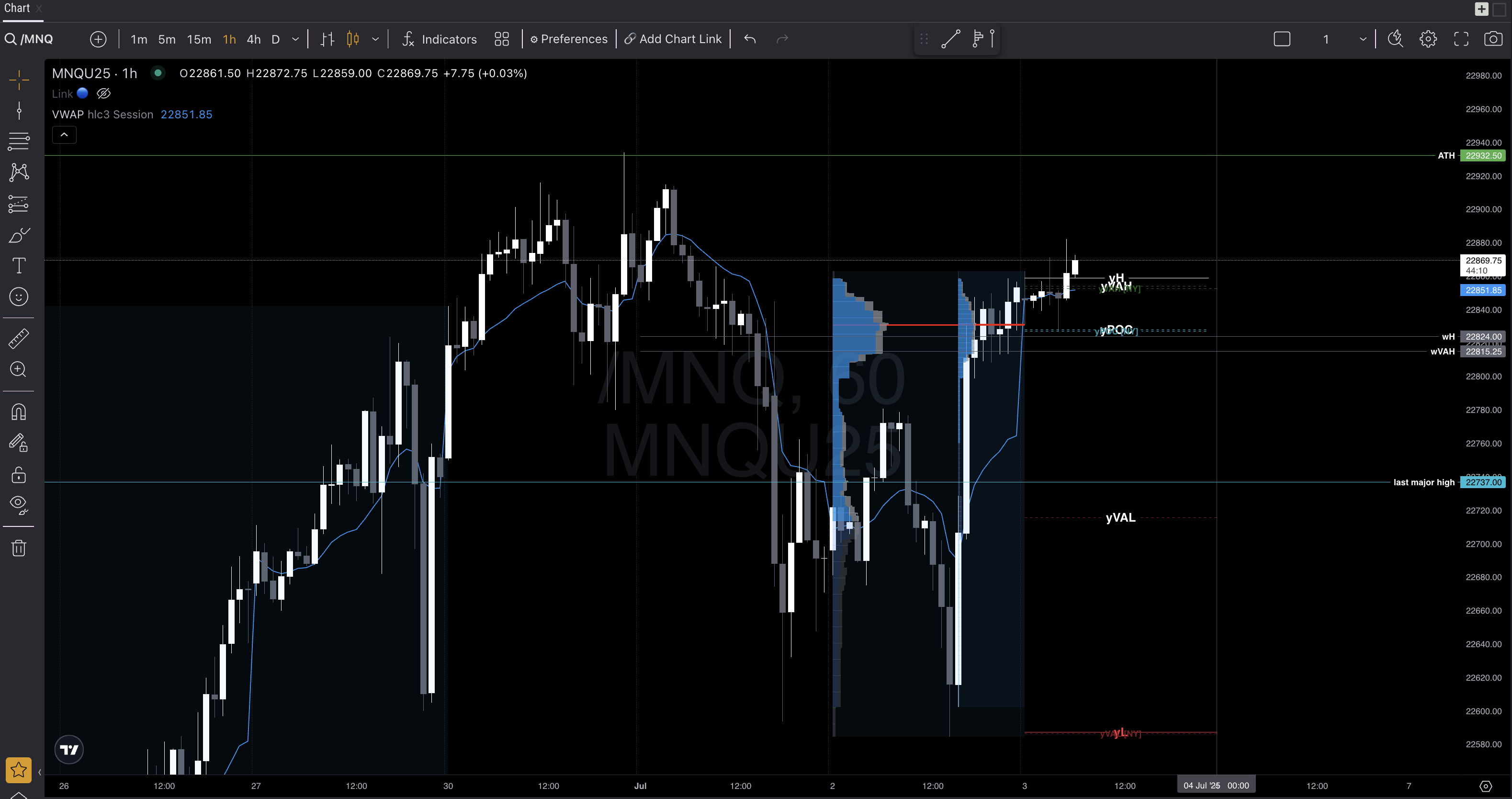The #1 Futures Trading Strategy for Prop Firms

3 Key Takeaways
- Structure > Setup.
A simple strategy with clear execution rules beats a complex one that changes every week. - If it can’t survive prop firm rules, it’s not a real strategy.
This approach works because it was built under pressure, not in a vacuum. - Consistency comes from clarity, not cleverness.
You don’t need a new trick. You need a process that keeps you out of your own way.
The Strategy That Finally Made Trading Work for Me (After Years of Getting Smacked by the Market)
Let’s not pretend this is going to be another “I discovered this one weird trick” article.
Because the truth is—I didn’t discover anything. I just stopped doing the dumb stuff.
If you’ve been around the futures and prop firm world for more than five minutes, you already know how this goes. You start with hope, get crushed by overtrading, indicators, drawdown rules, then bounce around from strategy to strategy like a caffeinated squirrel. Been there. Multiple times.
What changed for me wasn’t a new setup. It was deciding to stop reinventing the wheel every time the market slapped me around. I didn’t need more signals—I needed a system that held up when my confidence didn’t.
This article is the breakdown of that system.
Not theory. Not recycled YouTube fluff.
Just the one framework that’s actually kept me funded, profitable, and relatively sane while trading live with real firms like Tradeify, Top One Futures, TickTickTrader, and a few others I rotate through depending on payout schedules, challenge structures, and—let’s be honest—who’s not annoying me this month.
I’m not saying this is the strategy for everyone.
But it’s the one I built after getting my ass handed to me enough times to finally listen.
Let’s break it down properly.
The Years It Didn’t Work
“All the ways I blew up, reset, over-optimized, and spiraled.”
If you think this is going to be one of those origin stories where I magically go from blowing accounts to full-time trader in three months—sorry, wrong blog.
Let me just be honest: I’ve failed more evaluations than I care to count.
Most of them weren’t even close. Some I barely made it past day three.
And looking back? It wasn’t the market’s fault. It wasn’t the prop firm rules. It was me.
I was impatient, scattered, and trying to trade like five different people at once.
Here’s what didn’t work:
- Jumping into trades without structure.
Just vibes and “this looks good.” Spoiler: it wasn’t. - Over-leveraging because I was “behind on the profit target.”
As if pressing harder ever helped under pressure. - Stacking indicators like I was building a tech startup.
RSI, MACD, Bollinger Bands, EMA crossovers. All that clutter—none of the clarity. - Chasing firms with unrealistic payout promises.
APEX? Yeah, not a fan. I wrote why here. - Thinking more complexity = more control.
I had no idea how to just let a trade breathe. I was either micromanaging or panicking.
It’s wild how long it took me to realize:
The problem wasn’t the setup. It was the lack of structure.
The more firms I cycled through, the more I realized most traders weren’t failing because their strategy sucked.
They were failing because they had no system at all.
No defined sessions.
No level map.
No trade plan.
No mental framework when things went sideways.
I didn’t need to “find alpha.” I needed to stop sabotaging myself.
And that’s when I started building something that could actually hold under pressure—not just look good on screenshots.
What Actually Works (And Why It’s So Boring)
“It’s not sexy. But it works. Here’s why.”
The setup that finally started working for me doesn’t look exciting on Instagram.
There’s no triple-screen matrix. No neon indicators. No “$1,000 in 10 minutes” backtest screenshot.
What it does have? Structure. Simplicity. Stress-resilience.
And that’s why it’s survived when my psychology didn’t.
This isn’t something I cooked up over a weekend.
It’s what emerged after blowing up accounts, rage-quitting multiple prop firm dashboards, and realizing I either needed to simplify—or quit.
🧱 1. Price Action—But Only in the Right Context
Let’s be real: “price action” gets thrown around way too loosely.
Most traders think it just means “watching candles.”
But raw price action without market context is useless. You’re just staring at movement without meaning.
Here’s how I use it:
- Higher Timeframe Bias Comes First.
I start with Daily, 4H, and 1H. I want to know:- Are we in a breakout, a pullback, or mid-chop?
- Are we near any HTF key levels, imbalance zones, or recent rejections?
- Then I Drop to 15M, 5M, or 1M for Execution.
- I’m not entering anything just because it hits a line.
- I’m watching how it reacts. Candle structure, wick rejections, volume spikes, liquidity sweeps.
- For example: if we sweep the previous day’s high during NY open, spike delta, then drop hard with a full-body bearish close on 5M? That’s a potential setup.
This keeps me grounded.
I’m not trying to predict—I’m reacting to what the market is actually telling me.
📐 2. VWAP & Volume Profile—My Non-Negotiables
Every prop firm trader eventually figures this out:
Without a level map, you’re flying blind.
VWAP and Volume Profile gave me that map.
- VWAP = My heartbeat of the session.
- Above = bull bias, below = bear bias—unless we’re in compression.
- I use it for mean reversion, for structure confirmation, and for “don’t touch this zone” signals.
- Example: If we’re bouncing off VWAP for the third time after a micro pullback, I’ll often look for a breakout continuation—especially if Delta’s confirming.
- Volume Profile = My roadmap.
I track:- Current session POC, VAH, VAL
- Yesterday’s session POC, VAH, VAL
- Previous week POC, VAH, VAL when needed
- Plus daily high/low, NY session open, etc.
Why? Because:
- HVNs act like magnets or chop zones.
- LVNs = likely rejection or fast moves.
- POC shifts = potential change in market control.
I build my levels every morning. It’s like brushing my teeth.
If I skip it, I trade worse. Every. Single. Time.
🕒 3. Session Timing Isn’t Optional—It’s the Edge
I’m based in Germany. So for me, London open and early New York are the only sessions I take seriously.
Not because they “feel right.” But because that’s when the volume arrives.
You can trade during Asia or midday chop if you like pain and confusion.
But if you want clean moves backed by actual liquidity—time matters.
Here’s how I look at it:
- London session (8–10 CET) → Good for pre-positioning or first sweeps of major levels.
- NY Open (14:30 CET) → Often the real move. This is when I want to be ready.
- NY Lunch? Skip. I’m not a masochist.
I watch how price behaves around session opens—does it sweep the previous session’s high/low and reverse? Or break, retest, and go?
These reactions are gold. But only if you’re actually paying attention.
💡 4. Entry Logic—Structure First, Trigger Second
I trade pullbacks and breakouts—but never in isolation.
I ask:
- Is the breakout clean or desperate?
- Is the pullback into a structure zone I trust (VWAP, POC, HTF level)?
- What does Delta say? Are buyers/sellers trapped or in control?
I love when:
- Price pulls into a prior NY session high + yVAH
- Volume drops
- Then 1M candle shows clear absorption
That’s usually my cue.
I might enter on the next candle or wait for a lower timeframe trigger.
But I never enter “because I’m late” anymore. That’s rookie energy.
🛑 5. Know What Not to Trade
Here’s a hard truth:
Most of the day is just noise.
The more I focused on when not to trade, the more consistent I got.
I skip:
- Sessions with low volatility
- Midday chop
- Sloppy structure without a clean bias
- Days I’m not mentally present (sleep deprived, distracted, etc.)
Discipline isn’t just stop-losses.
It’s knowing when your edge isn’t there—and not forcing it.
Live Chart Breakdown: A Real Trade Setup with My Exact Thought Process
“This is how I read the market—with structure, not guessing.”
Let’s move from abstract to applied.
Here’s a recent NQ (MNQ) 1H chart from July 3rd, 2025. Nothing cherry-picked—just a clean structure, live session, and a few clear levels that triggered my attention.

Let me walk you through what I saw and how I approached it:
1️⃣ Context from the Left: Market Structure + HTF Clues
We’re coming off a sharp liquidation wick on July 2nd, which tested below 22700 and immediately reversed. That’s a clear signal: buyers stepped in, defended a prior structural low, and volume kicked up.
On the way back up, we cleared the prior VAH and POC, showing control shifted bullish again.
That’s HTF directional context—we’re in a retrace-to-continuation scenario.
2️⃣ Volume Profile Tells the Real Story
What stood out instantly on this day:
- yPOC + yVAH stack up below current price
→ Tells me price is accepting above value. That’s bullish if sustained. - Current session building a balanced profile above prior VAH
→ Could lead to breakout continuation or failed auction and fade. I’m open to both—depends on trigger. - Today’s VWAP (22851.85) is acting as a magnet + short-term support.
→ Several tests into VWAP with buyers holding.
These layers told me:
Bias is long—but only if we stay above VWAP/yVAH.
3️⃣ Key Levels That Mattered
Here’s what I marked before even thinking about an entry:
- VWAP: primary intraday support
- yVAH / yPOC: if price dips here and holds → long opportunity
- Session high: if NY pushes above → breakout continuation target
- ATH (22932.50): potential exhaustion / fade zone if reached too fast
4️⃣ The Trade Idea: VWAP + Structure Rejection for Long
What I looked for:
- Pullback into VWAP or yPOC zone
- Buyers defending with bullish reaction candle
- Delta not confirming seller strength
- Entry on 5M or 1M with a clean stop structure (below VWAP or low-volume node)
This is not about catching tops or bottoms.
It’s about trading into structure with clear invalidation.
5️⃣ Risk Framing
Let’s say I risked 10 ticks on MNQ, targeting:
- Previous session high → +20 ticks
- ATH if momentum builds → +40 ticks
But if VWAP fails and we push under yPOC? I'm out.
That’s the beauty—clear trade invalidation means no overthinking.
Final Thought: This Is Why Structure Wins
I didn’t need a news catalyst, a magic candle, or a guru signal.
Just:
- Clear directional bias
- Volume levels doing their job
- Session context respected
- Price giving me a clean place to define risk
This is how I trade.
And once I locked this approach in—my stats, psychology, and payout flow got cleaner.
This Strategy Under Pressure (Where It Really Proves Itself)
“Evaluations, trailing drawdown, payout phase—this is where most traders blow it.”
Let’s be honest.
Anyone can make a strategy look good in hindsight or on a cherry-picked chart.
But prop firm pressure is a different beast.
You’re not just managing trades.
You’re managing:
- The evaluation clock
- Your daily drawdown limits
- The weird psychology of “I’m almost at the payout”
- And of course, the platform quirks, data feeds, and random moments of “wait, did I just violate?”
Let me tell you—this strategy holds up under that heat.
✅ Evaluation Phase: Fast, but Not Forced
Here’s the mistake I kept making early on:
I tried to “speedrun” challenges.
Result? Break rules. Overtrade. Burnout. Reset.
What I do now instead:
- I treat every evaluation as if it were already funded.
- I cap my daily risk to 15–20% of the total DDL allowed.
- I don’t “optimize” to hit profit targets fast—I just trade my plan and let compounding do its thing.
With this structure (HTF > LTF > VWAP > Profile), I don’t need to force 20-point runners.
I can stack 5–10 point base hits and get to target without stress.
Especially on firms like Tradeify, TickTickTrader, Blue Guardian Futures, and TopOneFutures, where the rules don’t kill you for being human.
🧠 Payout Phase: Where Most Traders Sabotage
Getting funded is not the same as getting paid.
This is where risk control and emotional discipline become everything.
How I handle it:
- Lock in green weeks. Even if it’s just $200, I want consistent payout flow.
- Size down after big wins. That ego spike? Deadly. I reduce size right after a great day.
- Treat payout accounts like I’m managing other people’s money. That shifts the mindset fast.
My trades get even more selective during payout.
No “maybe” setups. Only structured, level-backed, session-respected trades.
🔧 Tech & Tools That Help (But Don’t Trade for Me)
For tracking and staying sane:
- TradingView for analysis
- Journalytix or Notion for journaling
- Volume Profile + VWAP custom levels
- Cumulative Delta tools for confluence (but not decision-making)
But let’s be clear:
No tool fixes a bad process. It just makes a good process cleaner.
I journal every session. Not just the trades, but the why behind them.
That’s what keeps the strategy evolving.
This strategy didn’t just help me pass challenges.
It helped me show up like a professional in every phase—from eval to payout to scaling.
And once you build a strategy that can survive that pressure?
You stop caring about indicators, magic systems, or Reddit opinions.
You just trade.
Why Most Traders Overcomplicate Everything (And Blow It)
“You’re not failing because you’re missing something. You’re failing because you’re adding too much.”
I know this one personally.
For years I thought I wasn’t seeing success because I didn’t know enough.
So I added more. More indicators. More timeframes. More YouTube. More Discord channels.
All it gave me? More confusion.
Here’s the trap: the more tools you add without a structure, the more ways you find to second-guess yourself.
One signal says “buy,” another says “wait,” your gut says “jump in,” and then price rips the other way—and now you’re frozen, pissed off, and looking for another strategy to start over with tomorrow.
At some point, I had to get brutally honest with myself.
All this “learning” was just avoidance.
Avoiding simplicity. Avoiding accountability. Avoiding real structure.
Because real structure forces you to face two truths:
- You already know what you’re doing wrong.
- You’re just not doing what you say you’ll do.
And yeah, that’s uncomfortable.
But once I stripped everything down to just core context (HTF bias, VWAP, volume levels, clean sessions), things got clearer.
Not always easier. But definitely more consistent.
This strategy didn’t magically make me immune to drawdowns or bad trades.
What it gave me was something to come back to when my psychology wobbled.
It’s a home base. A north star. A reason not to jump strategies every time the market throws a curveball.
And the funny thing? Once I stopped tweaking everything, my edge actually started to show up.
My Personal Rules for Keeping It Clean
“This is how I show up every day—without burning out or blowing up.”
Let me say this straight: strategy alone doesn’t keep you consistent.
What keeps you consistent is how you treat the strategy.
How you prepare for it. How you follow through.
And most importantly—how you stay out of your own way when things get messy.
For me, this means sticking to a few personal rules. Nothing dramatic. Just non-negotiables I’ve built over time by screwing it up, journaling it, and figuring out what actually helps me stay consistent.
First: I never trade without a clear HTF read. If I can’t describe in one sentence what the higher timeframe is doing—breakout, pullback, compression—I don’t trade. Period. I’m not here to play guessing games.
Second: levels are gospel. I build my VWAP, value areas, and POC zones before the session starts. Always. These aren’t just lines—they’re my map. If price isn’t reacting to these zones or isn’t near one, I wait. No reaction, no trade.
Third: if I’m not mentally clear, I reduce size—or don’t trade at all. Sounds simple, but most traders force it. You’re tired, stressed, or distracted, and you still try to “get one good setup.” I’ve done that. Lost more often than not. These days, I’d rather walk than give the market my worst version.
Also—and this one was hard to learn—I don’t “chase” after a missed setup. If it’s gone, it’s gone. I used to immediately drop down to 1M to find some re-entry. That almost always put me in at the worst price. Now I just let it go. There’s always another one. The cleaner I stay, the easier they are to catch.
And last: I journal every day. Not just wins and losses, but how I felt, what I saw, and what I ignored. That’s where the real growth happens. You’ll see your own patterns if you’re honest enough to look.
Keeping it clean doesn’t mean being perfect. It means being deliberate.
Deliberate with prep. Deliberate with risk. Deliberate with execution.
That’s what separates consistent traders from chaotic ones.
And if you’re trying to pass prop firm challenges, or protect your funded account, this kind of structure isn’t optional—it’s survival.
Trading This Way Feels Different (And That’s the Point)
“Once you stop trying to outsmart the market and just follow structure, everything changes.”
When I first started to trade like this—calm, structured, measured—it honestly felt… weird.
No more FOMO entries.
No more chasing the open because “it’s moving fast.”
No more relying on someone else’s chart in some Discord group.
Just my plan. My levels. My execution.
And silence.
It was uncomfortable at first because I wasn’t getting that dopamine hit.
You know the one. The rush when you click buy without a plan and pray it moons.
I wasn’t doing that anymore. And for a while, it felt like I wasn’t “doing enough.”
But over time, that shifted.
Now, clean trades feel better than adrenaline trades.
Waiting for price to come into my zone, seeing the reaction, pulling the trigger—and watching it work, because it’s supposed to work there?
That’s addicting in a whole different way.
I’m not saying I never mess up. I do.
I misread the bias. I get shaken out too early.
But even when that happens, I know exactly what went wrong—and I can fix it the next day.
Compare that to the old version of me, where after every loss I’d rewrite my rules, try a new indicator, or convince myself that “the market was manipulated.”
Now it’s just: was the setup clean? Did I follow structure? Did I manage risk?
If yes, I can live with any outcome. If not, I fix it.
That’s what I mean by “trading feels different.”
There’s a confidence that comes from consistency—not just in results, but in behavior.
When you stop being reactive and start being systematic, your entire relationship with trading changes.
You’re no longer hunting setups. You’re just waiting for the market to walk into your trap.
And when it does—it’s game on.
If You’re Still Lost, Start Here (My Final Advice)
“Don’t copy me—copy the structure.”
Look, if you’ve made it this far and you’re still thinking,
“Okay… but what’s the entry signal?”
—you’ve missed the point.
The power of this strategy isn’t in some magic setup.
It’s that it gave me something I could actually stick to.
Something that works under pressure. In real prop environments. With real risk. Real rules.
So if you’re still lost, here’s where I’d start:
Forget “finding edge.” Start by removing all the clutter.
Open your chart. Strip it down. VWAP, Volume Profile, and maybe some basic HTF levels. That’s it.
Pick one session to focus on.
Learn how it behaves. Watch it like a hawk.
London or NY is enough—don’t spread yourself thin.
Journal every session. Not just what happened—but what you saw, what you felt, and where you hesitated.
Over time, patterns show up. Not just in the market—but in you.
Keep risk tight. Tighter than you think.
Not because it’s “conservative”—because it’s scalable.
The goal is staying in the game long enough to figure yourself out.
Most importantly: stop switching strategies every time the market doesn’t give you what you want.
That’s the cycle keeping you stuck.
You don’t need more tools.
You need one clear structure that you trust enough to keep showing up for—even on the boring days.
Especially on the boring days.
This strategy isn’t perfect.
But it’s mine. And it works.
Not because it guarantees profit—but because it gives me clarity, consistency, and control in an industry that feeds on confusion.
If that’s what you’re after—then maybe it can be yours too.
🎁 Win a $100,000 TopOneFutures Challenge
Every month, I’m giving away one 100K Futures evaluation from TopOneFutures worth $225.
⚠️ Exclusively to new newsletter subscribers. Enter your email. Get in the draw. Get weekly high-value content and best offers, no BS.
Enter Now & Win a 100K Challenge

.png)


.jpeg)
.webp)

.webp)
.jpeg)
.png)
.png)
.jpeg)
.jpeg)


.png)

.png)






.png)
.png)
.jpeg)
.jpeg)

.jpeg)
.png)
.jpeg)




.jpeg)


.webp)
.webp)
.webp)